danbricklin.com/log
|
|
|
Reports about previous years:
|
Nantucket Conference 2002
|
The conference was in early May 2002 on the island of Nantucket off of Cape Cod, Massachusetts. The trip there on the ferry was listed as going to be "rough". It was. (For pictures of the ferry and Nantucket, look at my reports from 2000 and 2001.)
As usual, there was a welcoming reception, and then dinner on your own. I got to try out another nice Nantucket restaurant with Scott Kirsner and some of the other conference organizers.
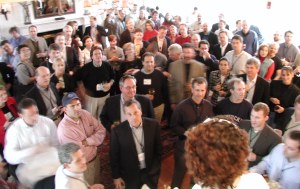 Welcoming reception
Nantucket has interesting vehicles that people sometime park on the streets:
  Seen on the streets: Old Jeep fixed with Band-Aids
We all got together for a buffet breakfast before the first session:
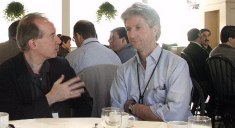 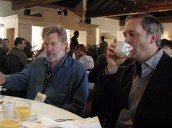 Dan Gillmor and Sam Whitmore, Lew McCreary and George Colony
The conference is small, and takes place in a nice cozy room that encourages comments from the audience.
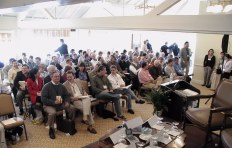 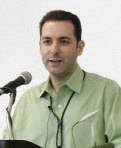 Half of the audience before Scott Kirsner kicked it off
The first major item was "Tech Veterans Read the Tea Leaves" with the head of Fidelity's Center for Applied Technology, Senior VP Charles Brenner, Marina Hatsopoulos, CEO of 6-year old Z Corporation, Frank Moss of Bowstreet, and Bill Warner, founder of Avid Technology (the video editing pioneers) and Wildfire Communications (voice-recognizing telephone assistants). It was moderated by Scott Kirsner, writer for the Boston Globe every Monday, Wired, Fast Company, etc.
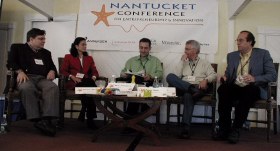 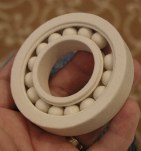 Charles Brenner (Fidelity), Marina Hatsopoulos (Z Corporation), Scott Kirsner, Frank Moss (Bowstreet), and Bill Warner (Avid/Wildfire/new stuff); a part made as one piece by Z Corp's machine including working ball bearings
Marina showed some of the parts made with their 3-D printers. Using something that started out as cornstarch stuck together with ink from an inkjet printer driven by CAD software output, their "printers" let companies like BMW, Porsche, Nike, colleges, etc., build prototypes earlier in the development process. Really cool. Notice how they can build parts inside of parts -- such like the ball bearings inside the rings. (She passed around a neat toy that had weird shapes within shapes.) The newer units do color. From $33K to $175K. Up to 16" x 20" x 24". Sales are good.
Here are some of the things I thought I heard said (most are not specifically quoted by name, as we were asked):
Scheduled panelist George Bell (CEO Upromise, former CEO of Excite@Home) canceled at the last minute (plane canceled by weather). From then on people would say that "...and George Bell is at home..."
Next up: "Fireside Chat" (well, there was no fire...) with Forrester Research CEO George Colony and Lotus/EFF/etc. founder Mitch Kapor.
 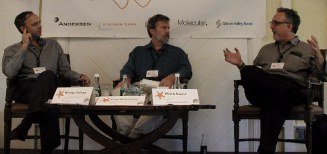 Bob Metcalfe, Patricia Seybold; George Colony (Forrester), Lew McCreary (CXO Media), Mitch Kapor
For the rest of the day my notes are pretty slim. From George: Think long-term. Important to last. From Mitch: He swings between the poles of profit and nonprofit. While talking about a scholarship program he's involved in that helps very poor people go to college, he stated: "Helping 1 or 2 or 3 individuals is as important as making software used by 5 million people."
The trivia game show had lots of nice prizes (flashlights, CD cases, books, and 2 tickets to the Red Sox from Boston.com). One question nobody got right, even though it was multiple choice and they give you lots of chances: What's the new name for Trellix's old "Trellix Web" product? (Patrick Rafter of Bluesocket, who led that session, used to work at Trellix.) The answer is "CuteSITE Builder". (That's our old Windows client-side product, now sold by GlobalSCAPE, who also sells CuteFTP. We licensed it to them and they pay us for the rights. That product is not what we're concentrating on now. Our server-side software for private label browser-based web site authoring is still called Trellix Web Express and is still sold by us with new customers announced all the time.)
All I remember from the VC and M&A talk was how they are busy with old businesses, have lots to invest, and need to invest in large chunks (asked later: Was it because they can't afford to hire enough people to sift through the little chunk businesses and still pay high VC wages? That's what it sounded like), and "Read a book on telecom -- it only had one chapter -- it was eleven."
The last speaker of the day was David Weinberger. He gave a new talk based on his new book, "Small Pieces Loosely Joined" [link to Amazon]. A really great, entertaining speech. If he gives it again and you can hear him, do. If not, read the book. It made me want to and I've started reading it on the plane flight while I write this (it's good). He shows how the Web is more than the "knowledge" we are used to dealing with. Here's the way I describe some of what I understood: If you want to deal with facts we can (supposedly) prove, you can describe a company with a balance sheet and income statement. But so much that is important to us as people are not "facts". (As Enron taught us.) He calls it Knowledge "Anorexia", limiting "knowledge" to "facts". The Web has more than facts -- it has jokes, feelings, links that show a desire to share. (Imagine that, according to David. With a link the author is telling you to leave his web page and go somewhere else. The opposite of the dotCom "sticky eyeballs" -- a horrible image of its own, David said.) We show more of ourselves. The line between private and public selves is much different on the web. All this leads to more real knowledge. (This is just some of what he, and the book, cover.)
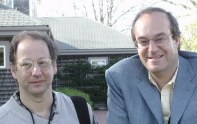  David Weinberger and Bill Warner outside the conference room, first posting of this page viewed on a browser on my Handspring Treo to show people at dinner
When I got back to the hotel in the late afternoon, I found that Dan Gillmor had pointed to this web log, saying I'll have some good stuff soon. Yech! That meant I had to quickly post some pictures (which I did), and let people know to come back later for more commentary. Now I had to take better notes. I wasn't planning to do such a thorough job this year. At dinner I complained to Dan. He said he did it purposely to push me to write more. Ah, the downside of trying to keep up a web log.
The next day opened with a panel on biotech. Some notes:
I asked a question. Listening to them talk, I heard that they needed software to help them, but that there wasn't enough of a market to pay for big development. I heard about patent litigation, the sport of kings, being a normal tool. I heard that big companies were needed to sell anything. It didn't seem like a small effort was possible. In the computer field, major contributions were made by small groups: Tim Berners-Lee with the Web, Shawn Fanning with Napster, and more. We have Open Source projects for letting companies join together to develop what they need. In fact, the advances in our industry, and inexpensive Linux, made advances like Google possible, and maybe helped them decode the Genome much faster than expected. Venture capital is only used for some of the advances. Is there something that could be done to improve the structure of their industry? They didn't seem to get my question, thinking I was knocking patents (not my point).
  Biotech panel: John Benditt - editor-in-chief of Technology Review, Alison Taunton-Rigby - Forester Biotech, Mitchel Sayare - ImmunoGen, John Santini - MicroCHIPS, Jonathan Jay Rosen - CIMIT; Last panel: Peter Burrows - Reebok, Valeri Marks - Sockeye Networks, Patricia Seybold - Patricia Seybold Group, Paul Gaffney - Staples, John McEleney - Solidworks
The next session was "Building Effective Technology Organizations". Some points:
 Bob Metcalfe ended the conference with his "last word" session. He tries to sum things up, in a funny way. He reminded the biotech people that "Information technology is the sun, biotech is a planet". We did word processing, database, spreadsheet. We'll do biotech. The VCs talked about "Lots of money in deep pockets, but short arms." He told a story of how he went into Staples and asked where he could find an Ethernet cable. The young sales clerk, with piercings all over her face, lit up and took him to an aisle full of cables. "We have all types, in different colors and lengths. Now, you have to know whether you want a straight-through or a crossover..." she explained in a perky voice. Upon hearing an explanation down to the crossover, as the inventor of Ethernet he knew he had succeeded. We then had a long discussion, started by a lawyer in the audience, about venture capital, companies that make profits vs. return to investors in VC funds, and more. Bob, who had been doom and gloom the last two years, ended by saying there has never been a better time than now. There's lots of money, people and office space are in abundance and cheap, and more. Bob Metcalfe ended the conference with his "last word" session. He tries to sum things up, in a funny way. He reminded the biotech people that "Information technology is the sun, biotech is a planet". We did word processing, database, spreadsheet. We'll do biotech. The VCs talked about "Lots of money in deep pockets, but short arms." He told a story of how he went into Staples and asked where he could find an Ethernet cable. The young sales clerk, with piercings all over her face, lit up and took him to an aisle full of cables. "We have all types, in different colors and lengths. Now, you have to know whether you want a straight-through or a crossover..." she explained in a perky voice. Upon hearing an explanation down to the crossover, as the inventor of Ethernet he knew he had succeeded. We then had a long discussion, started by a lawyer in the audience, about venture capital, companies that make profits vs. return to investors in VC funds, and more. Bob, who had been doom and gloom the last two years, ended by saying there has never been a better time than now. There's lots of money, people and office space are in abundance and cheap, and more.That's my report. You can read what David Weinberger had to say about the conference, what Dan Gillmor had to say, Boston.com's report, or my reports from the conference last year and the year before.
|
|
|
© Copyright 1999-2018 by Daniel Bricklin
All Rights Reserved.
|